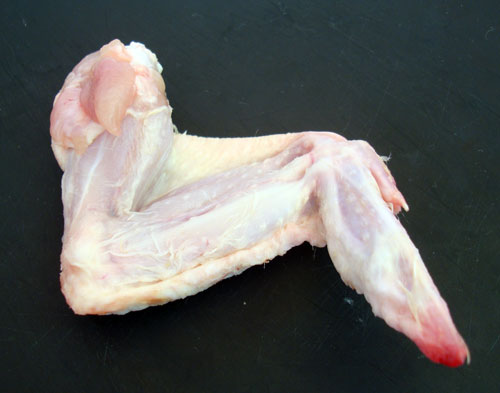Wash the chicken in running water, cos you don't know where the butcher stored it. Be suspicious always. Place the chicken on its back, make certain you have a sharp cleaver and knife. For that you get an oil-stone to sharpen your knives, wet the blade and then holding the blade at an angle draw it up and down the stone about 10 or 15 times, both sides of the blade.
So now you have your defrosted bird on its back and a sharp cleaver and knife.
There are some goodies in the body cavity, reach inside and take out the liver, gizzard and feel for the heart and yank it out. Wash all three properly remove any loose fat from the gizzard and gut it in two. Chuck it into a deep bowl.
Next grab hold of one leg bend it. See where the joint is and place the blade of your cleaver or knife on it and bear down exerting pressure on the blade. It will go through the joint nicely. Why the joint? because then you don't get bone splinters when you cook. Make two deep nicks on the chicken leg so that when you cook it, it cooks to the bone easily and you don't get that disgusting pink or worse, bloody portion near the bone.
Do the same for the other leg.
Now grab the thigh, work it up and down to see where the joint is, place the blade of the knife or cleaver and bear down heavily. Be very careful at all times that your finger does not come under the blade. Score the thigh with two cuts to the bone.
Do the same for the other thigh.
Now go to the wings. Always cut out the small portion of the wing and keep it aside for a woggle you may know. Why I say this, is because some poultry farmers inject their birds in the wing tips with growth hormones. It may be an urban legend but no harm in taking a few precautions. Danielle, you told me, you heard that if the tip of the wing is pink or red, it is a fresh chicken. I get rid of that part though from the joint. So you are left with the lollipop and the wing.
Feel for the shoulder joint and cut there. If you want a fat lollipop cut a lot of flesh about an inch from around the joint, so you get a nice fat lollipop.
Do the same for the other wing.
Now your bird has no legs and no wings. Place your left hand over the breast area. Hold the cleaver flat, cut along the sides, through the ribs on both sides. Careful not to let the cleaver slip. Make sure your cutting board is not near the edge of the kitchen counter. It can slip off and your chicken will be all over the floor. I say this, cos it happened to me.
Cut up to the shoulder joint and force the blade through the joint. Both sides. Now you have the backbone area and neck separate from the breast portion.
Cut the breast portion any way you like. You can cut it in three horizontal pieces so you get the wish bone intact, or you can chop down vertically through the wishbone and have two large breast pieces.
All this goes into the deep bowl.
The back can be chopped into three or four sections, the neck into two. Put this in a separate bowl. The back and neck are very bony pieces and are great for boiling for soup, or making a killer chicken xacuti. Bony meat make superb soups and superb curries. Sprinkle a little salt, maybe a tablespoon of it (less is more) put in a clean clear plastic packet, not the recycled type, or wrap in plastic wrap and store in a box in the freezer.
CHICKEN MARINADE FUNDAS
Now take the deep bowl with the chicken pieces. Take a four finger and one thumb grab amount of salt. Sea salt is better, healthier than the table salt with all its chemicals. Sea salt has good bacteria that prevents cancers and Alzheimer's Disease. So, for cooking make certain you have at least 2 kilos of sea salt in your kitchen. The grey salt is great, but the pinkish salt is the best. The pure white is useless with all the grit washed out of it.
So sprinkle the 4-finger-and-thumb pinch of salt on the chicken pieces and massage them well. Then add a heaped tablespoon of ginger garlic paste. Massage. Add a tablespoon of soya sauce and a tablespoon of barbecue sauce or Bancal sauce, which you get in Goa, so Goa is the best place in the world to live since you get Bancal sauce here. Add a tablespoon of curd. Massage. Throw in a teaspoon (tsp) of haldi, a tsp of jeera, tsp of chilli powder, tsp of garam masala, tsp pepper, tsp dhania. Mix the whole lot thoroughly, add a tablespoon of lemon juice. Pour it all into a plastic bag, put in a box, store in a fridge and cook it whenever you like. It stays fine in a good fridge for even two months. That's the longest I've kept chicken. No it didn't grow a beard, or get any mould. And it tasted great.





.jpg)






